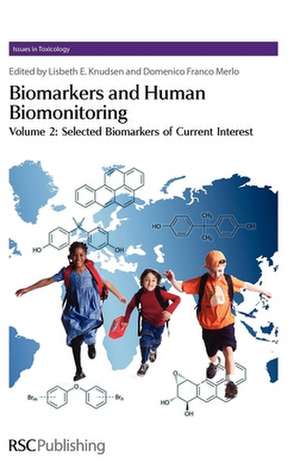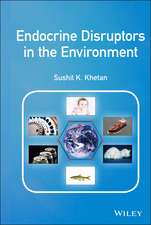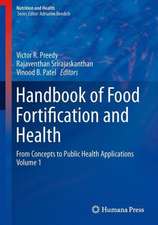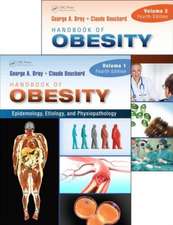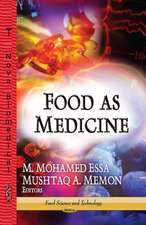Biomarkers and Human Biomonitoring, Volume 2: Selected Biomarkers of Current Interest: Issues in Toxicology, cartea 10
Editat de Lisbeth E Knudsen, Domenico Franco Merloen Limba Engleză Hardback – 31 oct 2011
Human biomonitoring has developed from a research tool in occupational and environmental health to identify and quantify exposures to harmful substances in urine and blood. The analytical methods for detection of substances in biological media have considerably improved with smaller detection limits and more precise and specific measurements. Human biomonitoring is a valuable tool in exposure estimation of selected populations and currently used in surveillance programs all over the world. This two volume set provides an overview of current available biomarkers and human biomonitoring programs in environmental health, which is timely given the present debate on adverse health effects from environmental exposures. The books decribe both previous and ongoing studies as well as the newer biomarkers of exposure and effects. Volume one describes current human biomonitoring programs in Germany, Romania, France, Canada, India and Belgium, providing convincing evidence of a global decline in human exposures to lead and increasing concern from exposure to endocrine disruptors and the genotoxic compound. Biomarkers of specific exposures to a wide range of widely used everyday compounds such as phthalates, PFCs, bisphenol A, brominated flame retardants, PAHs, dioxins, mercury and arsenic are also discussed. Volume two decribes human biomonitoing of exposures to environmental tobacco smoke, mycotoxins, physiological stress, hormone activity, oxidative stress and ionizing radiation, as well as effect biomarkers of hemoglobin adducts, germ cells, micronuclei and individual susceptability. The books will be essential reading for toxicologists, environmental scientists and all those working in the safety and risk assessment of chemicals.
Din seria Issues in Toxicology
- 5%
 Preț: 1253.11 lei
Preț: 1253.11 lei - 5%
 Preț: 1326.01 lei
Preț: 1326.01 lei - 5%
 Preț: 1538.96 lei
Preț: 1538.96 lei - 14%
 Preț: 2480.57 lei
Preț: 2480.57 lei - 5%
 Preț: 1361.12 lei
Preț: 1361.12 lei - 9%
 Preț: 1031.61 lei
Preț: 1031.61 lei - 14%
 Preț: 1211.87 lei
Preț: 1211.87 lei - 14%
 Preț: 1357.63 lei
Preț: 1357.63 lei - 5%
 Preț: 1134.46 lei
Preț: 1134.46 lei - 14%
 Preț: 1314.76 lei
Preț: 1314.76 lei - 14%
 Preț: 1404.09 lei
Preț: 1404.09 lei - 5%
 Preț: 1495.86 lei
Preț: 1495.86 lei - 5%
 Preț: 1508.68 lei
Preț: 1508.68 lei - 5%
 Preț: 1551.74 lei
Preț: 1551.74 lei - 5%
 Preț: 1268.59 lei
Preț: 1268.59 lei - 5%
 Preț: 1537.11 lei
Preț: 1537.11 lei - 5%
 Preț: 1526.14 lei
Preț: 1526.14 lei - 5%
 Preț: 2534.03 lei
Preț: 2534.03 lei - 5%
 Preț: 1537.11 lei
Preț: 1537.11 lei - 5%
 Preț: 1440.92 lei
Preț: 1440.92 lei - 14%
 Preț: 1230.53 lei
Preț: 1230.53 lei - 5%
 Preț: 1341.43 lei
Preț: 1341.43 lei - 14%
 Preț: 1387.76 lei
Preț: 1387.76 lei - 5%
 Preț: 1201.01 lei
Preț: 1201.01 lei - 14%
 Preț: 1218.32 lei
Preț: 1218.32 lei - 14%
 Preț: 949.86 lei
Preț: 949.86 lei - 5%
 Preț: 1300.31 lei
Preț: 1300.31 lei - 5%
 Preț: 1087.58 lei
Preț: 1087.58 lei - 14%
 Preț: 1136.73 lei
Preț: 1136.73 lei - 5%
 Preț: 1337.71 lei
Preț: 1337.71 lei - 5%
 Preț: 642.03 lei
Preț: 642.03 lei - 14%
 Preț: 1092.34 lei
Preț: 1092.34 lei - 5%
 Preț: 1045.29 lei
Preț: 1045.29 lei - 5%
 Preț: 1054.02 lei
Preț: 1054.02 lei - 5%
 Preț: 1158.47 lei
Preț: 1158.47 lei - 9%
 Preț: 1242.36 lei
Preț: 1242.36 lei - 5%
 Preț: 1440.62 lei
Preț: 1440.62 lei - 9%
 Preț: 1239.74 lei
Preț: 1239.74 lei - 9%
 Preț: 1034.00 lei
Preț: 1034.00 lei - 9%
 Preț: 1244.07 lei
Preț: 1244.07 lei - 9%
 Preț: 1169.42 lei
Preț: 1169.42 lei - 9%
 Preț: 1172.99 lei
Preț: 1172.99 lei - 9%
 Preț: 1031.38 lei
Preț: 1031.38 lei - 9%
 Preț: 1032.48 lei
Preț: 1032.48 lei - 5%
 Preț: 833.22 lei
Preț: 833.22 lei
Preț: 1073.50 lei
Preț vechi: 1130.00 lei
-5% Nou
Puncte Express: 1610
Preț estimativ în valută:
205.41€ • 214.47$ • 170.01£
205.41€ • 214.47$ • 170.01£
Carte tipărită la comandă
Livrare economică 05-19 aprilie
Preluare comenzi: 021 569.72.76
Specificații
ISBN-13: 9781849732420
ISBN-10: 1849732426
Pagini: 252
Ilustrații: 2 figures in Chapter 13 are in colour
Dimensiuni: 163 x 239 x 24 mm
Greutate: 0.64 kg
Editura: Royal Society Of Chemistry
Seria Issues in Toxicology
ISBN-10: 1849732426
Pagini: 252
Ilustrații: 2 figures in Chapter 13 are in colour
Dimensiuni: 163 x 239 x 24 mm
Greutate: 0.64 kg
Editura: Royal Society Of Chemistry
Seria Issues in Toxicology
Cuprins
Biomarkers of exposure - Hemoglobin adducts; Biomarkers of human exposure to environmental tobacco smoke (ETS); Biomarkers of exposure – mycotoxins: aflatoxin, deoxynivalenol and fumonisins; Biological measures and the psychosocial working environment; Micronuclei for human biomonitering; Biomarkers of individual susceptibility: genetic polymorphisms and their interplay with micronucleus frequencies Biomarker of effects on hormone functions; Biomarkers of Exposure - Oxidative Stress to DNA and Lipids – Relation to Air Pollution; Male and female germ cell biomarkers Biomarkers of exposure and effect: ionizing radiation; Ethics and data protection in human biomarker studies
Notă biografică
Lisbeth Knudsen received an MSc in Biochemistry in 1980 and PhD in Biomedicine 1993. Her present position is professor of experimental toxicology at the Department of Occupational and Environmental Health, The Institute of Public Health, University of Copenhagen. She was until 2009 a national member of the Scientific Advisory Committee (ESAC) for the European Centre for the validation of Alternative Methods (ECVAM) and is currently an active member of the EU Implementation Group on Biomonitoring. At the national level Lisbeth has coordinated several major biomonitoring studies within occupational health. She is the current Coordinator of the European Network on Children's Susceptibility and Exposure to Environmental Genotoxicants. She is an active participant in a number of EU-projects: COPHES (Consortium to Perform Human Biomonitoring on a European Scale), DEMOCOPHES (Demonstration of a Study to Coordinate and Perform Human Biomonitoring on a European Scale) and LIFE+ 09 ENV/BE00410. Lisbeth is also an active member of the Research Council of the Faculty of Health Sciences at the University of Copenhagen and the Danish Consensus Platform for 3R Alternatives to Animal Experimentation (DACOPA). In 2006 Lisbeth received the Nordic Alternative Price for promoting the development of alternatives to animal testing and she is the current coordinator of the Danish in vitro toxicology network and treasurer in the European Consensus Platform for 3R Alternatives to Animal Experimentation (ECOPA). Professor Domenico Franco Merlo received his Ph.D. in Environmental Health, Epidemiology from the University of Cincinnati, Ohio, USA in 1988. He is currently Director of the Unit of Epidemiology, Biostatistics and Clinical Trials, Department of Cancer Epidemiology and Prevention of the National Cancer Institute of Genoa, Italy. He coordinated and contributed to European and national studies on cancer risk associated with environmental and occupational exposure to crystalline silica, benzene, 2,3,7,8-TCDD, pesticides as well as studies including biomarkers of exposure, early biological effects, and individual susceptibility.
Textul de pe ultima copertă
Human biomonitoring has developed from a research tool in occupational and environmental health to identify and quantify exposures to harmful substances in urine or blood. The analytical methods for detection of substances in biological media have been considerably improved with smaller detection limits and more precise and specific measurements. Human biomonitoring is a valuable tool in exposure estimation of selected populations and is currently used in surveillance programs all over the world. This two-volume handbook provides an overview of current available biomarkers and human biomonitoring programs in environmental health, which is timely given the present debate on adverse health effects from environmental exposures. The books describe both previous and ongoing studies as well as the newer biomarkers of exposure and effects. Volume 1: Ongoing Programs and Exposures describes current human biomonitoring activities in Germany, Romania, France, Canada, India and Belgium, providing convincing evidence of a global decline in human exposures to lead and increasing concern related to adverse effects from exposures to endocrine disruptors and genotoxic compounds. Chapters are also included on biomarkers of specific exposures in a range of widely used everyday compounds such as phthalates, PFCs, bisphenol A, brominated flame retardants, lead, PAHs, dioxins, mercury and arsenic. Volume 2: Selected Biomarkers of Current Interest contains chapters describing human biomonitoring of exposures to environmental tobacco smoke, mycotoxins, physiological stress, hormone activity, oxidative stress and ionizing radiation, as well as chapters on exposure/early effect biomarkers such as hemoglobin adducts, germ cells, micronuclei and of individual susceptibility. The final chapter addresses ethical issues related to human sampling and monitoring.
Descriere
The books describe both previous and ongoing studies as well as the newer biomarkers of exposure and effects. Volume Two describes human biomonitoring of exposures to environmental tobacco smoke, mycotoxins, physiological stress, hormone activity, oxidative stress, and ionizing radiation, as well as effect biomarkers of hemoglobin adducts, germ cells, micronuclei, and individual susceptibility.
